Reviews
Kirjailijoiden Kalevala [The writer’s Kalevala]
7 February 2014 | Mini reviews, Reviews
 Kirjailijoiden Kalevala
Kirjailijoiden Kalevala
[The writer’s Kalevala]
Toim. [Ed. by]: Antti Tuuri, Ulla Piela ja Seppo Knuuttila
(Kalevalaseuran vuosikirja 92, the Kalevala Society’s yearbook 92)
Helsinki: Suomalaisen Kirjallisuuden Seura, 2013. 313 pp., ill.
ISBN 978-952-222-429-3
€47, hardback
The Kalevala is the Finnish national epic, compiled from oral folk poetry by Elias Lönnrot. It has provided a source of inspiration to Finnish culture since 1839. Kirjailijoiden Kalevala continues a project entitled ‘The artists’ Kalevala’, started in 2009. To start with, four scholars examine, from different viewpoints, the influence of folk poetry and the Kalevala on literature. Some twenty Finnish-language authors then approach the epic with original thoughts and literary means. The result may take the form of reminiscing, of a short story, poem or cartoon. In some texts the Kalevala is present only indirectly, in others some character of the epic is placed in the focus – Väinämöinen, Kullervo, Lemminkäinen or Aino. Kirjailijoiden Kalevala offers a multifaceted collection of viewpoints; aptly, the editors, in their foreword refer to the epic as a literary sampo, the mysterious, mythical object of the Kalevala that generates wealth and riches.
Decade of youth: the 1950s revisited
30 January 2014 | Reviews
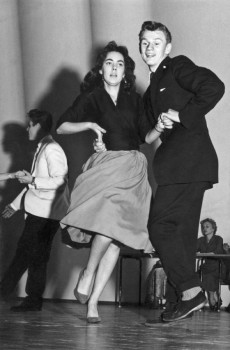
Rock around the clock in Helsinki, too! All photos here from Rasvaletti; photographer unknown, 1958
Rasvaletti. Valokuvia 1950-luvun Helsingistä /
Fotografier från 1950-talets Helsingfors
[Hair-grease. Photographs from 1950s Helsinki]
Työryhmä [working group]: Yki Hytönen, Tuomas Myrén, Riitta Pakarinen, Aki Pohjankyrö, Hilkka Vallisaari
Helsinki: Helsingin kaupunginmuseo, Helsinki City Museum,
2013. 211 pp., ill.
ISBN 978-952-272-499-1
€45, hardback
Onnen aika? Valoja ja varjoja 1950-luvulla
[Time of happiness? Light and shadow in the 1950s]
Toimittaneet [Ed. by]: Kirsi-Maria Hytönen & Keijo Rantanen
Jyväskylä: Atena, 2013. 249 pp., ill.
ISBN 978-951-796-924-6
38€, hardback
The 1950s rocked! They literally did – that is when the world got rhythm: Blue Suede Shoes by Elvis and the film Blackboard Jungle, with Bill Haley’s hit Rock Around the Clock, for example.
The development of new sound reproduction – long-playing records and tape recorders – was essential to the spreading of the gospel of rock and pop here, there and everywhere.
In Finland, the shocking new music was a smash hit among a group of young urban men called lättähatut, flathats, who also wore tight trousers, black overcoats and pointed shoes. Their girls dressed in angora sweaters and tight trousers or skirts. These teenagers, who hung around together very late in the evenings, were largely considered not only a nuisance but also a possible danger to the peaceful development of society (not only in Finland…). More…
Kuka on saamelainen ja mitä on saamelaisuus – identiteetin juurilla [Who is a Sámi and what being Sámi means – looking for the roots of identity]
30 January 2014 | Mini reviews, Reviews
 Kuka on saamelainen ja mitä on saamelaisuus – identiteetin juurilla
Kuka on saamelainen ja mitä on saamelaisuus – identiteetin juurilla
[Who is a Sámi and what being Sámi means – looking for the roots of identity]
Toim. [Ed. by]: Erika Sarivaara, Kaarina Määttä & Satu Uusiautti
Rovaniemi: Lapin yliopistokustannus (Lapland University Press), 2013. 182 pp.
ISBN 978-952-484-651-6
€29, paperback
This anthology updates one of the most burning questions, one which also has political consequences: who has the right to belong to an indigenous people, and who is entitled to define it? Of the approximately 100,000 Sámi – the only indigenous people in the European Union – around 7,000 live within Finnish territory. The writers represent Sámi research at the Lapland University, and they examine the definition of ‘the Sámi without a status’, i.e. people not included on the election list for the Sámi Parliament. The book questions the prevailing discourse, which characterises Sámi history as a withdrawal from the progress of civilisation; this is interpreted as a survival strategy, and the Sámi are not primarily regarded as the victims of colonialism and modernisation. The work also highlights the inner hierarchies of the Sámi and analyses both the reindeer-farming Sámi, regarded as elite, as well as the marginalia, the Sámi who engage in forestry and agriculture to make a living. Articles are sensitive, sometimes provocative, and they shine a spotlight on every ethnic group as well as the fundamental questions of the individual, the right to one’s own identity, language and history.
Hannu Raittila: Terminaali [Terminal]
23 January 2014 | Mini reviews, Reviews
 Terminaali
Terminaali
[Terminal]
Helsinki: Siltala, 2013, 454 pp.
ISBN978-952-234-174-7
€32.90, hardback
The airport is a fertile environment for a contemporary novel: a crucible of chance encounters. In his sixth, extensive novel, Hannu Raittila (born 1956) masterfully combines plot and structure: there is adventure, personal relationships, hard living, a love affair, life on a remote Swedish-speaking island. Commodore Lampen sets out to look for his daughter Paula, who has been forcibly brought back to Finland after spending years touring foreign airports. Back in the 1990s Paula and her friend Sara spent a lot of time at Helsinki airport, which developed its own culture of international encounters; this then took them abroad – by accident, on 11 September 2001. Various adventures ensued, including an involvement with the Syrian civil war. Globalisation is based on the free mobility of goods and people, but it also means crumbling of societal structures, and in Raittila’s novel – paradoxically enough – the growing rarity of human encounter.
Mikko-Olavi Seppälä & Riitta Seppälä: Aale Tynni. Hymyily, kyynel, laulu [Aale Tynni. A smile, a tear, a song]
16 January 2014 | Mini reviews, Reviews
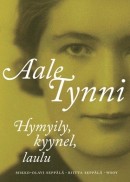 Aale Tynni. Hymyily, kyynel, laulu
Aale Tynni. Hymyily, kyynel, laulu
[Aale Tynni. A smile, a tear, a song]
Helsinki: WSOY, 2013. 488 pp., ill.
ISBN 978-951-0-38306-3
€37, hardback
The poet, author and translator Aale Tynni (1913–1997), an Ingrian Finn who came to Finland as a refugee after the First World War in 1919, published 15 collections of poetry between 1938 and 1987. Among her translations are works by Ibsen, Shakespeare, Yeats and Racine. This extensive biography, compiled and written by Tynni’s daughter Riitta Seppälä and her grandson, historian Mikko-Olavi Seppälä, is an in-depth, lively portrait of a poet who, in her time, was both admired and criticised for her choices of form and content. Tynni felt that classical metrical tradition was closest to her, and patriotism was one of her themes; however, in the postwar years the freedom of rhythm of Finnish modernism began to flourish, and politics also gained strength in the literary world. In 1948 Tynni won the gold medal for literature in the – rather bizarre and short-lived – art competitions at the Summer Olympics in London with her poem ‘Laurel of Hellas’. Tynni experienced dramatic turns in her personal life; she underwent a prolonged divorce from her first husband who bitterly fought it. Two of her three children committed suicide in adulthood. She was finally free to marry the widowed poet Martti Haavio (aka P. Mustapää) in 1960, a marriage of soulmates that lasted until Haavio’s death in 1973.
Malin Kivelä & Linda Bondestam: Bröderna Pixon och TV:ns hemtrevliga sken [The Pixon brothers and the homely shimmer of the telly]
9 January 2014 | Mini reviews, Reviews
 Bröderna Pixon och TV:ns hemtrevliga sken
Bröderna Pixon och TV:ns hemtrevliga sken
[The Pixon brothers and the homely shimmer of the telly]
Helsingfors: Schildts & Söderströms, 2013. 38 pp.
Illustrerad av [Illustrated by] Linda Bondestam
ISBN 978-951-523-124-6
€22, hardback
Finnish translation:
Pixonin pojat ja TV:n kotoisa kajo
Suomentanut [translated by] Maarit Halmesarka
Helsinki: Teos, 2013. 38 pp.
ISBN 978-951-851-524-4
€27.90, hardback
The four Pixon brothers spend their time watching the telly and eating cereals and sweets. Their mother, in desperation, constantly demands that they go out and play, but they just don’t. The thin brothers’ teeth are bad as they have no vitamins in their blood: indeed they are as fit as 90-year-olds. One day the telly goes bust and the brothers end up in their neighbours’ home, where the two ladies cook them a good meal. They finally do go out and play – until the point of exhaustion: the story presents the reader with sinister turns à la Grimm brothers or Hoffmann, which the gloomy, dark pictures, suddenly devoid of colours, comically illustrate. But colours return to the pictures as well as to the brothers, who are now as fit as any 64-year old! This is the authors’ second book for children. Kivelä’s lesson takes the mickey out of didacticism but does not lose the point, so fun is had by all. Bondestam’s detailed, graphic pictures spice the story with amusing horror.
Kreetta Onkeli: Poika joka menetti muistinsa [The boy who lost his memory]
9 January 2014 | Mini reviews, Reviews
 Poika joka menetti muistinsa
Poika joka menetti muistinsa
[The boy who lost his memory]
Helsinki: Otava, 2013. 111 pp.
ISBN 978-951-1-27022-5
€22.90, hardback
Kreetta Onkeli, better known for her books for adults, was awarded the 2013 Finlandia Junior award for this book. Arto is a schoolboy who loses his memory, but goes off in search of himself with an open mind. He meets a number of people who are outsiders in various ways and learns important lessons from each of them. Onkeli portrays a child of around 11 to 13 who is confused by many things. Researchers consider this age group to fall into an in-between area: there aren’t enough appealing activities on offer for kids of this age, who are treated as an awkward bunch both at home and at school. This book contains some rule-breakers: the boys eat at a restaurant buffet without paying and ride the subway without a ticket while other characters hint at forging official documents. Adult readers with their eyes closed to reality might consider Arto’s odyssey an anxiety-inducing vision of the future, in which grown-ups are not shown in a flattering light. Children, however, will get wrapped up in this absurd adventure.
Translated by Ruth Urbom
Alexandra Salmela: Kirahviäiti ja muita hölmöjä aikuisia [The giraffe mummy and other silly adults]
9 January 2014 | Mini reviews, Reviews
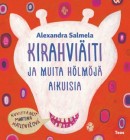 Kirahviäiti ja muita hölmöjä aikuisia
Kirahviäiti ja muita hölmöjä aikuisia
[The giraffe mummy and other silly adults]
Kuvitus [Ill. by]: Martina Matlovicová
Helsinki: Teos, 2013. 96 pp., ill.
ISBN 978-951-851-466-7
€27.90, hardback
The first children’s book by Alexandra Salmela, who has previously published a novel for adults, brings some sorely needed anarchy to Finnish storybooks. The 21 brief stories encourage children to add to them, whether by drawing, writing or out loud. Salmela’s tales are populated by trolls, dragons, knights and princesses, as well as ordinary children with silly parents. A boy called Ossi has two mums: Little Mum and Big Mum. One night, Little Mum collapses under the Tree of Exhaustion, but Ossi and his little sister hug their mum better. Allu’s absent-minded dad manages to mislay his head, and two perfect parents trade in their defective son Sulo at the child repair shop. The collage images by Slovakian illustrator Martina Matlovičová will work their way straight into your subconscious and start to bubble away.
Translated by Ruth Urbom
Jukka Laajarinne & Timo Mänttäri: Isä vaihtaa vapaalle [Dad takes time off]
9 January 2014 | Mini reviews, Reviews
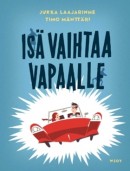 Isä vaihtaa vapaalle
Isä vaihtaa vapaalle
[Dad takes time off]
Kuvitus [Ill. by]: Timo Mänttäri
Helsinki: WSOY, 2013. 31 pp., ill.
ISBN 978-951-0-39780-0
€26.90, hardback
Isä vaihtaa vapaalle is a picture book infused with wry humour which lends itself to both realistic and fanciful readings. In the story, a girl’s father is a secret agent. He’d like to reduce his working hours to spend more time with his daughter, but his employer has other ideas. This book provides an amusing reflection of its time: parents’ job titles often do not mean much to children, so their strange roles and the heavy briefcases parents lug home start to take on a life of their own in children’s minds. The story is free from clichés about gender roles and will entertain boys and girls alike. Timo Mänttäri, making his debut as a children’s book illustrator here, depicts fast-paced, dangerous situations and amusing details. The comic book-style narrative and large, double-page illustrations create suspense in this zippy story. The words and pictures are seamlessly integrated, and the not-overlong text is balanced by the exceptionally strong, expressive visuals.
Translated by Ruth Urbom
Riitta Jalonen & Kristiina Louhi: Aatos ja Sofian meri [Aatos and Sofia’s sea]
9 January 2014 | Mini reviews, Reviews
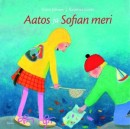 Aatos ja Sofian meri
Aatos ja Sofian meri
[Aatos and Sofia’s sea]
Kuvitus [Ill. by]: Kristiina Louhi
Helsinki: Tammi, 2013. 36 pp., ill.
ISBN 978-951-31-7048-6
€21.90, hardback
The duo of Riitta Jalonen and Kristiina Louhi has come up with yet another well-rounded picture book trilogy. Aatos and Sofia are sensitive, independent preschoolers, each with a good imagination and the ability to savour fleeting moments. It is rare for children’s books to contain such a nuanced yet natural portrayal of companionship and devoted friendship between children. Sofia has her feet more firmly planted on the ground that Aatos, who is more prone to let his emotions run free. Sofia’s mum’s aerobics sessions are a fun contrast with the children’s slower-paced lifestyle, in which they hold on to individual moments. This book champions children’s free, creative play and their right to a long childhood. Kristiina Louhi’s illustration style is both traditional and extremely modern.
Translated by Ruth Urbom
Juba: Minerva. Alajuoksun kelluva pullukka [Minerva. The floating dumpling of the Lower Reaches]
9 January 2014 | Mini reviews, Reviews
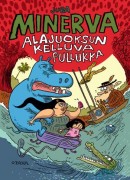 Minerva. Alajuoksun kelluva pullukka
Minerva. Alajuoksun kelluva pullukka
[The floating dumpling of the Lower Reaches]
Helsinki: Otava, 2013. 48 pp., ill.
ISBN 978-951-1-25731-8
€17.80, hardback
Minerva is a cartoon character who has appeared in two previous volumes (2006, 2009) by Juba, a.k.a. Jussi Tuomola. Juba is the creator of an extremely popular comics series for adults about the woman and the pig (both male chauvinist and porcine), Viivi and Wagner. Minerva is a brave and extremely resourceful little heroine who is never daunted by even the wildest adventures she experiences after leaving home to fly around in weird lands. Petra, the floating dumpling of the Lower Reaches, is a woman with magical powers who likes to travel in a flying gondola. In this volume Minerva also meets other old friends on her journey under water, underground, on a river and in the air above a jungle, in pursuit of a rare ingredient for a perfume that Petra has determined to acquire no matter what. The comedy in the uninhibitedly fantastic adventures, illustrated effectively in cartoon squares of different sizes, will amuse readers of many ages.
Riina Katajavuori & Salla Savolainen: Pentti ja kitara [Pentti and the guitar]
9 January 2014 | Mini reviews, Reviews
 Pentti ja kitara
Pentti ja kitara
[Pentti and the guitar]
Kuvitus [Ill. by]: Salla Savolainen
Helsinki: Tammi, 2013. 32 pp., ill.
ISBN 978-951-31-6646-5
€22.90, hardback
Even early-years education is packed with activities these days. Pentti has a large extended family who really know how to have fun. He wants to learn how to play the guitar as well as his uncle Jaska. His mum tries to suggest an instrument she thinks would be more appropriate, but Pentti will not be put off. The Pentti picture book series is attractive for its nostalgic style; you can never be quite sure whether the era depicted is in the past or the present day. In this story, Riina Katajavuori focuses on what’s essential, yet still manages to convey the basics of playing the guitar – including dissonance and Jimi Hendrix. Salla Savolainen’s illustrations effectively capture the excitement of a child’s new hobby.
Translated by Ruth Urbom
Laura Lähteenmäki: Iskelmiä [Hits songs]
9 January 2014 | Mini reviews, Reviews
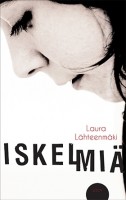 Iskelmiä
Iskelmiä
[Hit songs]
Helsinki: WSOY, 2013. 230 pp.
ISBN 978-951-0-39493-9
€28.90, hardback
Laura Lähteenmäki addresses the difficult topics of friendship and loyalty in her novels for young adult readers. Now she has taken on an important topic: the right of a girl approaching adulthood to set boundaries around her body and mind. Sixteen-year-old Aino is a good girl who hasn’t had time for anything in her life besides her involvement in the Girl Guides. Her mother’s unemployment has repercussions on their family relations, and Aino turns elsewhere to escape the melancholy atmosphere at home. Interest from her classmate Samuli comes at an opportune time, but inexperienced Aino is confused by his erratic emotions.The depiction of emotional and physical abuse in this novel is grimly authentic. Lähteenmäki provides an excellent sense of a girl’s feeling of detachment and her struggle between her environment and the pressures she has created for herself.
Translated by Ruth Urbom
Katri Tapola & Karoliina Pertamo: Toivon talvi [Toivo’s winter]
9 January 2014 | Mini reviews, Reviews
 Toivon talvi
Toivon talvi
[Toivo’s winter]
Kuvitus [Ill. by]: Karoliina Pertamo
Helsinki: Tammi, 2013. 23 pp., ill.
ISBN 978-951-31-7047-9
€14.90, hardback
Most Finnish board books have been following the contemporary trend for strong colour palettes with pared-down character designs. Toivon talvi is a refreshing exception to the rule, dealing with everyday things children experience in their lives. One-year-old Toivo loves being outdoors. What’s most fun is when his mum comes out and plays with him. The first snowfall of the year causes him some confusion, but gradually Toivo learns to get the best out of the joys of winter. Katri Tapola’s story, with its child-friendly pacing which genuinely empathises with little ones’ fickle emotions, focuses on the boy’s everyday routines, thus conveying a sense of security. Karoliina Pertamo’s characters are simple sketches yet expressive enough to suit small children.
Translated by Ruth Urbom
Ville Hytönen & Matti Pikkujämsä: Hipinäaasi, apinahiisi [Donkeymonkey]
9 January 2014 | Mini reviews, Reviews
 Hipinäaasi, apinahiisi
Hipinäaasi, apinahiisi
[Donkeymonkey]
Kuvitus [Ill. by]: Matti Pikkujämsä
Helsinki: Tammi, 2013. 32 pp., ill.
ISBN 978-951-31-7043-1
€24.90, hardback
In Ville Hytönen’s gently educational tale, some woodland creatures poke fun at a wheezy donkey and an oddball monkey. In the end, the animals who were the target of derision turn their unusual characteristics into strengths. Then they all make up, all the residents of the forest launch into an exuberant dance, and the earlier teasing is forgotten. Matti Pikkujämsä has been an extraordinarily productive in recent years: his illustrations have appeared in numerous newspapers and magazines as well as children’s books. Hipinäaasi, apinahiisi, which is his first solo picture book, features rhythm and movement; sometimes he creates extremely elaborate ornamentation, while other images calm the eye with spare yet colourful scraffito techniques.
